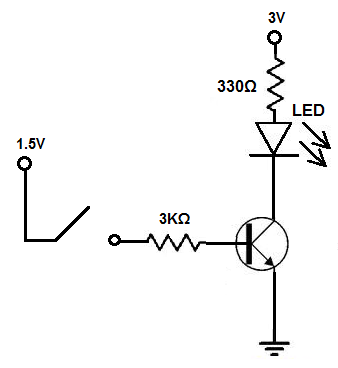How to Build a Simple LED Driver Circuit

In this project, we will show how to build a simple LED driver circuit.
A LED driver circuit is a circuit which can power on and light an LED>
We will simply use a transistor and a few resistors to bring about a circuit which, with minimal current, can produce enough current to drive and light an LED.
The point of this circuit is to demonstrate that if you do not have sufficient current powerful enough to drive an LED, you can connect a transistor to the circuit so that it provides enough current amplification to drive it.
Of course, if you're powering an LED and you can connect the LED directly to a power source, you won't need a very sophisticated driver circuit. There will be enough power from that power source to light up the LED without the need for a transistor. However, say you have a circuit that is operating off the power supplied by a chip and the chip can only output a very low amount of current. This current may not be enough to drive an LED. Or you may have a chip that allows for enough current to light an LED but you may want to light several LEDs in parallel. For each LED that you want to light in parallel, about 15mA of current are needed more per LED. A chip such as the Atmega168 or Atmega328 allows for about a maximum of 20mA of current output per output pin. Thus, you could drive a single LED on an output pin. However, if you wanted to drive 2 LEDs in parallel, you would need a driver circuit to get more current. Thus, driver circuits using transistors, are very common.
This circuit exploits the fact that transistors can function as current amplifiers in circuits. We use the transistor to supply the amplification necessary so that the LED can be driven.
The parts we need to run this circuit are shown below.
Parts
- NPN 2N2222 transistor (or similar)
- SPST Switch
- LED
- 3 AA Batteries or DC power supply
- 330Ω Resistor
- 1KΩ Resistor
For the transistor, we simply use an NPN transistor. This will be sufficient for providing amplification.
To power the LED and the collector of the transistor, we provide 3 volts of power. This voltage is necessary for the transistor to work. NPN transistors always need
positive voltage applied to the collector in order to work. This is called reverse bias voltage so that the current in the transistor can flow from emitter to collector. This 3 volts can come
either from 2 AA batteries connected in series or from a DC power supply.
LED Driver Circuit
The schematic of the LED driver circuit we will build is shown below:

When the switch of the circuit is open, no current flows to the base of the transistor. Therefore, the transistor cannot turn on. Bipolar junction transistors need base current and sufficient positive voltage to the collector in order to provide amplification. So with no current, the transistor nor the LED turns on. When the switch is closed, base current flows through the transistor, turning it on. The transistor now provides amplification to the current, turning the LED on.
If the LED was just connected straight to the 10KΩ resistor, without any transistor, it would not produce sufficient current to drive the LED. The current through the LED would be I=V/R= 1.5V/3KΩ= 0.5mA. This is not sufficient to drive an LED. An LED typically needs about 15mA. With the NPN transistor in the circuit, amplification is usually to the degree of about 100 to 150. Therefore, the current will be amplified by 100, which is 0.5mA * 100= 50mA. 50mA is now sufficient to drive and light the LED.
So you see how the transistor allows a circuit to be an LED driver. Without it, there wouldn't be enough power to drive it. The point of this circuit is that if you have insufficient current output, you can create a driving, or amplifying, so that you can have sufficient current. LEDs are
current-driven devices. Therefore, an LED driver circuit is one that supplies sufficient current to drive them. This can be done with a simple transistor, as shown above.
Related Resources
How to Vary the Brightness of an LED
How to Build an LED Flasher Circuit
How to Build a Relay Driver Circuit
How to Build a Dark-activated Light Circuit
How to Build a Blinking LED Circuit
